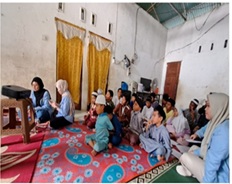Penatalaksanaan dan Pencegahan Penyakit Pedikulosis Kapitis pada Anak Panti Asuhan Management and Prevention of Pediculosis Capitis in Orphanage Children
Main Article Content
Abstract
Pediculosis capitis is a common parasitic infestation in humans and often affects children. This disease is caused by head lice, Pediculus humanus var. capitis, an ectoparasite that infests the scalp and hair with the main symptoms being itching and irritation of the scalp. Generally, children who are infested with head lice do not show serious symptoms, but in some children, it can cause problems in the form of sleep disturbances and loss of concentration when studying and this will disrupt the child's growth and development. An orphanage is a place to live with a group of children who are at risk of head lice infestation. This community service activity aims to carry out head and hair examinations, provide management for children who are positively infested with head lice, and provide education for eradicating and preventing this disease to orphanage residents. This activity was successfully carried out at the Air Jamban Village Orphanage, and the incidence of pediculosis capitis was found to be 30.7%. Children who are infested with head lice are given pharmacotherapy treatment in the form of 1% permethrin lotion and non-pharmacotherapy in the form of a wet comb. To prevent this disease, education was carried out in the form of counseling and an increase in the knowledge of the orphanage residents was obtained before and after the education. It is hoped that this activity can improve the health status of orphanage residents.
Downloads
Article Details

This work is licensed under a Creative Commons Attribution-ShareAlike 4.0 International License.
Authors who publish with this journal agree to the following terms:
- Any article on the copyright is retained by the author(s).
- Author grant the journal, right of first publication with the work simultaneously licensed under a Creative Commons Attribution License that allows others to share work with acknowledgment of the work authors and initial publications in this journal.
- Authors are able to enter into a separate, additional contractual arrangements for non-exclusive distribution of published articles of work (eg, post-institutional repository) or publish it in a book, with acknowledgment of its initial publication in this journal.
- Authors are permitted and encouraged to post their work online (e.g., in institutional repositories or on their websites) prior to and during the submission process, as can lead to productive exchanges, as well as earlier and greater citation of published work.
- The article and any associated published material is distributed under the Creative Commons Attribution-ShareAlike 4.0 International License
References
Apet, R., Prakash, L., Shewale, K. H., Jawade, S., & Dhamecha, R. (2023). Treatment modalities of pediculosis capitis: A narrative review. Cureus, 15(9). https://doi.org/10.7759/cureus.45028
Cummings, C., Finlay, J. C., & MacDonald, N. E. (2018). Head lice infestations: A clinical update. Paediatrics and Child Health (Canada), 23(1), e18–e32. https://doi.org/10.1093/pch/pxx165
Fu, Y. T., Yao, C., Deng, Y. P., Elsheikha, H. M., Shao, R., Zhu, X. Q., & Liu, G. H. (2022). Human pediculosis, a global public health problem. Infectious Diseases of Poverty, 11(1), 1–15. https://doi.org/10.1186/s40249-022-00986-w
Leung, A. K. C., Lam, J. M., Leong, K. F., Barankin, B., & Hon, K. L. (2022). Paediatrics: how to manage pediculosis capitis. Drugs in Context, 11, 1–15. https://doi.org/10.7573/dic.2021-11-3
Maryanti, E., Lesmana, S. D., & Novira, M. (2018). Hubungan faktor risiko dengan infestasi Pediculus humanus capitis pada anak panti asuhan di Kota Pekanbaru. Jurnal Kesehatan Melayu, 1(2), 73. https://doi.org/10.26891/jkm.v1i2.2018.73-80
Maryanti, E., & Lestari, E. (2020). Pendidikan kesehatan dalam rangka menuju panti asuhan bebas pedikulosis kapitis di Kecamatan Siak Hulu Kabupaten Kampar. Riau Journal of Empowerment, 3(2), 97–103. https://doi.org/10.31258/raje.3.2.97-103
Maryanti, E., Lestari, E., Wirdayanto, A., Mislindawati, M., Firja, W., & Devlin, M. (2024). Pemeriksaan dan pengobatan dalam rangka pemberantasan pedikulosis kapitis pada anak panti asuhan. Jurnal Abdimas Madani Dan Lestari (JAMALI), 06(September), 112–117. https://doi.org/10.20885/jamali.vol6.iss2.art4
Maryanti, E., Lestary, E., Wirdayanto, A., Firja, W., & Devlin, M. (2023). Pemeriksaan dan edukasi infeksi parasit dan jamur pada kulit dan rambut anak Panti Asuhan Desa Pelintung Kecamatan Medang Kampai Kota Dumai. In Laporan Pengabdian Fakultas Kedokteran Universitas Riau. https://doi.org/10.30656/ka.v5i2.5667
Mumcuoglu, K., Pollack, R., Reed, D., Barker, S., Gordon, S., & Toloza, A. (2021). International recommendations for an effective control of head louse infestations. International Journal of Dermatology, 60, 272–280. https://doi.org/10.1111/ijd.15096
Neuberg, M., Banfić, I., Cikač, T., Ribić, R., Zember, S., & Meštrović, T. (2022). Knowledge, attitudes, psychosocial perspectives and applied epidemiology in the control of head lice (pediculosis capitis) in Croatian Preschool Children: A Qualitative Study on Childcare Professionals and Health Coordinators. Children, 9(1), 1–16. https://doi.org/10.3390/children9010066
Nutanson, I. ., Steen, C. ., Schwartz, R. ., & Janniger, C. (2008). Pediculus humanus capitis: an update. Acta Dermatoven APA, 17(4), 147–159. https://www.researchgate.net/publication/23686310_Pediculus_humanus_capitis_An_update
Putri, L. A. (2019). Faktor risiko pedikulosis kapitis di panti asuhan. Sriwijaya Journal of Medicine, 2(3), 197–204. https://doi.org/10.32539/sjm.v2i3.81
Sungkar, S., Dwinastiti, Y. A., Haswinzky, R. A., Irmawati, F. P., Wardhana, A. W., Sudarmono, P., & Buntaran, S. (2019). Effectiveness of wet combing compared with 1% permethrin lotion for the treatment of pediculosis capitis. International of Applied Pharmaceutics, 11(06), 108–110. https://doi.org/10.22159/ijap.2019.v11s6.33570
Toghroli, R., Hosseini, Z., Ziapour, A., Yari, A., Rahimi, S. F., & Mehedi, N. (2022). Explaining the determinants of pediculosis control and prevention: A Qualitative study in Southern Iran. Inquiry (United States), 59, 1–12. https://doi.org/10.1177/00469580221086369
Tohit, N. F. M., Rampal, L., & Mun-Sann, L. (2017). Prevalence and predictors of pediculosis capitis among primary school children in Hulu Langat, Selangor. Medical Journal of Malaysia, 72(1), 12–17. https://pubmed.ncbi.nlm.nih.gov/28255134/
